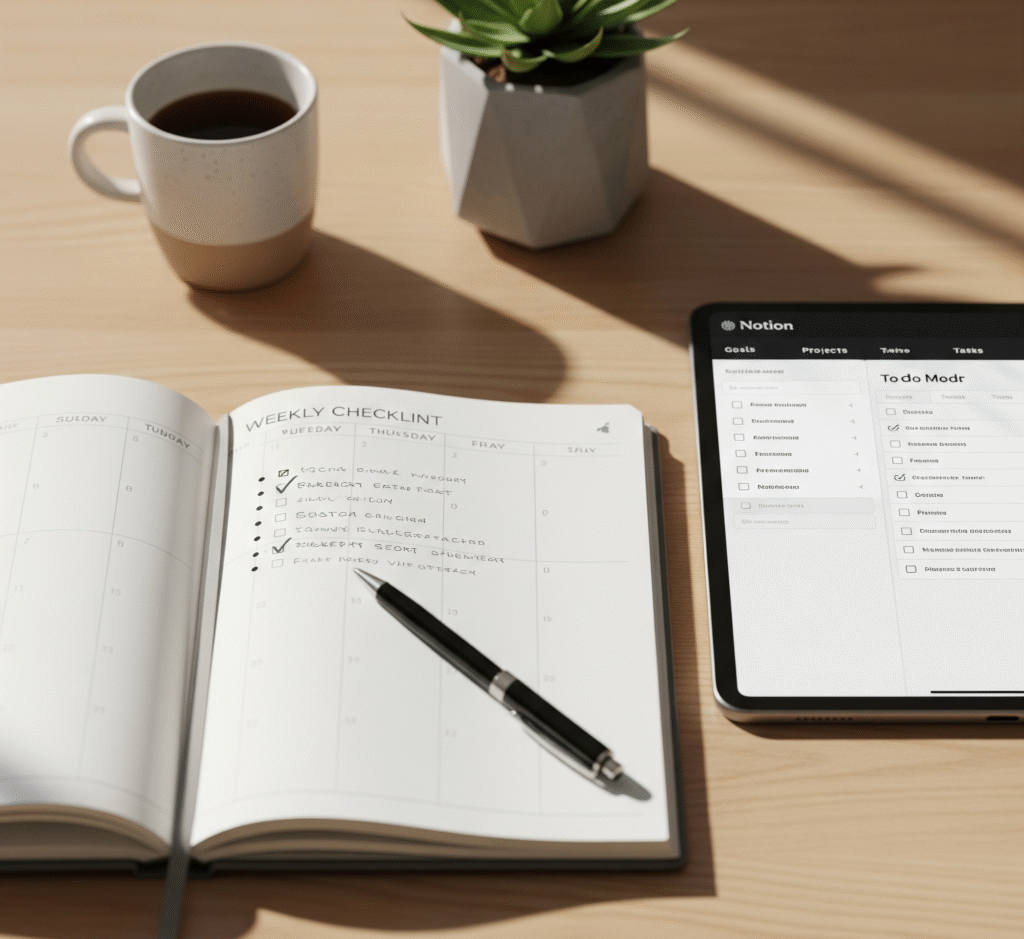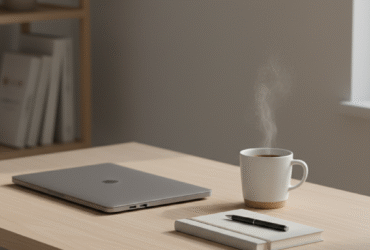Ever felt like the week just slipped past you, leaving a trail of unfinished tasks, scattered notes, and a tired brain? I used to start Mondays already carrying the clutter from the week before—half-written to-do lists, unanswered emails, a desk that looked like it had hosted a storm. No wonder my focus never felt fresh.
That’s when I built a weekly reset system—a simple rhythm that clears out the mental and digital junk so I can start every week with clarity. Think of it like washing the dishes before cooking: small, intentional resets create space for flow.
In this article, I’ll share exactly how my weekly reset works, why it matters, and how you can shape your own. The goal isn’t more productivity pressure. It’s about creating a calm foundation that supports your best work and your best self.
Why a Weekly Reset Matters
A weekly reset is not about doing more—it’s about doing less, more intentionally. It’s a checkpoint that helps you:
- Clear lingering clutter (physical, mental, or digital).
- Reflect on what worked and what didn’t.
- Set gentle priorities for the week ahead.
Without one, it’s easy to carry chaos forward. Your mind stays in reactive mode, chasing tasks instead of leading them. But with a reset, you gift yourself clarity. And clarity is what makes focus possible.
Ask yourself: How different would your week feel if you entered it with a clean slate?
Step 1: Reset Your Space
Our environment quietly dictates our energy. A cluttered desk pulls at your attention even if you’re not consciously noticing it.

Quick Space Reset Ritual
- Clear off your desk entirely.
- Wipe the surface (yes, the crumbs too).
- Put back only the essentials—laptop, notebook, pen.
- Add one grounding item (a candle, plant, or photo).
I find this takes less than ten minutes, but it completely shifts how Monday feels. My mind stops buzzing because my space signals: it’s time to focus.
Key takeaway: A clean desk is not decoration—it’s an anchor for your mind.
Step 2: Reset Your Mind
A weekly reset isn’t only about your environment; it’s about your inner state. I use a short reflection ritual every Sunday evening (or Monday morning if I’ve had a full weekend).
My Reflection Questions
- What went well this week?
- Where did I feel drained?
- What small shift could make next week smoother?
This isn’t journaling for perfection. It’s simply noticing. Often, a single insight—like realizing that late-night scrolling wrecked my mornings—guides the adjustments I need.
Step 3: Reset Your Tasks
To me, this is the heart of the reset: reviewing what’s on my plate and shaping it into something manageable.

My Simple Process
- Review last week’s to-dos. Carry over what still matters.
- Delete what no longer feels relevant.
- Highlight the 3 most important things for the week ahead.
If everything is a priority, nothing is. Picking three creates focus. Sometimes, that means finishing a client project, setting up a health appointment, or making space for writing.
Pro tip: I use Notion to track weekly tasks—it keeps everything in one view and reduces the scattered post-it note chaos.
Step 4: Reset Your Calendar
Tasks live in lists. But if they never find space in your calendar, they remain abstract. I’ve learned that actually blocking time is what makes things real.
Calendar Reset Checklist
- Review fixed commitments (meetings, appointments).
- Place your three top priorities into open time blocks.
- Leave white space for rest and flexibility.
It’s not about cramming every hour. It’s about ensuring the important work actually gets air.
Step 5: Reset Your Digital Clutter
Nothing derails focus faster than a messy inbox or a desktop littered with files.
My Digital Reset Ritual
- Zero out my downloads folder.
- Archive or delete emails until only active threads remain.
- Close browser tabs I no longer need (or save them into Notion).
It’s amazing how much lighter my brain feels when my laptop greets me with calm, not chaos.
Key takeaway: Digital clutter is mental clutter in disguise.
Step 6: Reset Your Energy
This is where many reset systems stop, but for me, energy is the fuel behind it all. I always ask: how can I start the week with more lightness?

Simple Energy Resets
- Prep healthy snacks or meals for Monday and Tuesday.
- Move my body—often a long walk while listening to music.
- Plan one thing I’m excited about that has nothing to do with work.
Without energy, even the best-planned week collapses. With it, flow feels natural.
Step 7: Reset Your Focus Rituals
Every reset ends with setting up small rituals that keep me aligned. These aren’t about willpower; they’re cues that guide me back into focus.
My Rituals
- Light a candle when starting work.
- Use the same playlist for deep focus sessions.
- Do a 2-minute stretch before shifting between projects.
Tiny signals like these train your brain: this is focus time.
Building Your Own Weekly Reset
You don’t need my exact system. The beauty of a weekly reset is that it bends to your life. Start small—pick one or two resets that resonate most.
Some people begin with just resetting their space. Others start with calendar reviews. The important part is consistency. It’s less about what you do and more about when you do it.
Common Mistakes to Avoid
- Overcomplicating it. A reset should be light, not another burden.
- Skipping reflection. Without pausing to notice what drained or energized you, you’ll repeat the same patterns.
- Treating it as optional. The weeks I skip my reset are always the ones where I feel most scattered.
Tools That Support a Weekly Reset
I don’t use many tools, but a few have made the process smoother:
- Notion (affiliate link): My hub for weekly tasks and reflections.
- Google Calendar: For visualizing my week.
- Headspace (affiliate link): For short guided reflections and resets.
The tools don’t create focus. They just support the habits that do.
A Glimpse Into My Reset Routine
Here’s what it looks like in practice:
Sunday evening, I clear my desk, light a candle, and put on calm music. I open Notion, review last week’s notes, and jot down what worked. Then I look at my calendar and block time for the big three. By the end, my mind feels lighter, like I’ve exhaled.
It takes me about 45 minutes. That single hour shapes the next seven days.
Why This System Sticks
I’ve tried dozens of productivity systems that felt like full-time jobs to maintain. The reason this reset works is because it’s simple, repeatable, and flexible.
- Simple enough to do in under an hour.
- Repeatable without much thought.
- Flexible enough to bend with busy seasons.
That’s the kind of system that becomes a rhythm, not a chore.
Conclusion: Your Reset, Your Flow
A weekly reset is not about perfection. It’s about creating breathing room so you can step into your week with clarity.
Key takeaway: The more intentional your reset, the more natural your flow.
My encouragement? Try your own version this week. Clear your desk, check in with yourself, pick your top three. See how it feels to start Monday lighter.
And if you want to build your reset digitally, I recommend trying [Notion](affiliate link). It’s been a gentle game changer for me.
Because simplifying isn’t about stripping life down—it’s about making space for what matters most.





